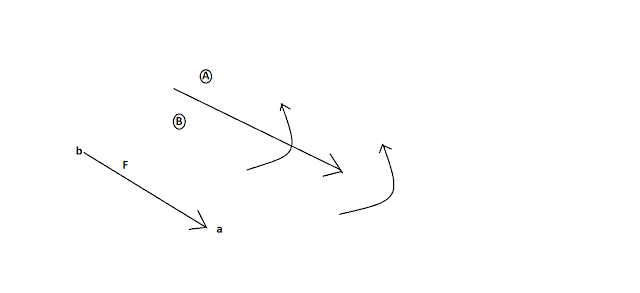When a body tends to move under the action of an external
force then some resistance will act opposite to the direction of motion between
the contact surfaces.This resistance is known as friction or frictional force.
In the other words , friction is the force that will act
between two contact surface opposite to the direction of motion.
Picture
R is the normal reaction [because it acts perpendicullary]
S = resultant reaction
S = (F2 + R2)1/2
φ = The angle made between normal reaction & resultant
reaction it is called the angle of friction.
tan φ = F/R = μ = co – efficient of friction.
F = μ R
ANGLE OF FRICTION
Picture
It is the angle made between the normal reaction and the
resultant reaction.
It is denoted by `φ’ (φ = Angle of friction)
CO-EFFICIENT OF ERICTION
picture
It is the ratio of the frictional force to the normal reaction
at the contact surface.
μ = frictional force/ normal reaction
μ = F/R = tan φ [F = μR]
here , μ is constant and always less than 1, value of μ
depends on the nature of the contact surface.
CONE OF FRICTION
Picture
When a body can move due to the application of an external
force , we find the resultant reaction (s) as shown in figure .It we replace
the external force (p) in opposite
direction then the resultant reaction also changes it’s position. The locus of
the resultant reaction will from an inverted cone like figure .The cone is
known as cone friction.
ANGLE OF REPOSE
Picture
If a body kept on a rough inclined plane and on increasing the
angle of inclined plane , the body can slides down the inclined plane for a
particular value of inclination.
The angle of inclined plane with the horizontal direction is
known as angle of repose.
PROVE THAT THE ANGLE OF REPOSE IS EQUAL TO THE ANGLE OF
FRICTION I.E. α = φ
LAWS OF FRICTION
LAWS OF STATIC FRICTION (COLUMB’S LAW OF FRICTION)
1.
The force of friction is always acting opposite
to the direction of motion of the body.
2.
The magnitude of the force of friction is
exactly equal to the force which tends to move the body CP = F
3.
The force of limiting friction bears a constant
ratio with the normal reaction (R) between the contact surface i.e. F/R =
constant = μ (co-efficient of froction)
4.
The force of friction is independent of the area
of the contact between the surface.
5.
The frictional force depends upon the roughness
of the surface in contact.
LAWS OF DYNAMIC FRICTION (SLIDING FRICTION)
1.
The force of friction always acts in a direction
opposite to the direction of motion of the body.
2.
The magnitude of kinetic friction bears a
constant ratio with the normal reaction between the two surface.The ratio is
called co-efficient of kinetic friction (μn) which is slightly less
than μ.
3.
For maximum speeds , force of friction remains
constant but the decreases with the increasese in speed.
USEFULL AND HARMFULL EFFECTS IN FRICTION
USEFULL EFFECTS
1.
It is impossible for every body to walk on the road without the effects of friction.
2.
Machineries can do useful work with the aid of
friction force.
3.
When we write something on the exercise book or
black board , it is due to friction.
4.
If we pullout nail from wood the frictional
force offer.
5.
When ladder is placed with its one end on the
vertical wall and the other end at floor , the frictional forces prevent the
ladder from slipping due to friction.
6.
When we do some work by our hands , things does
not slip from our hand due to frictional effect.
HARMFULL EFFECTS
1.
Large amount of power has been last due to
friction in engines, gears , trains , bearings etc.
2.
Changes of wirn out of machine tools due to
friction.
3.
When a fluid run over a pipe there is a chance of producing heat due to
friction.
4.
Heat generated due to fluid friction between air
and outer surface of air –craft.
5.
Due to frictional effects of dry leaves of a
forest , changes of great firing.






